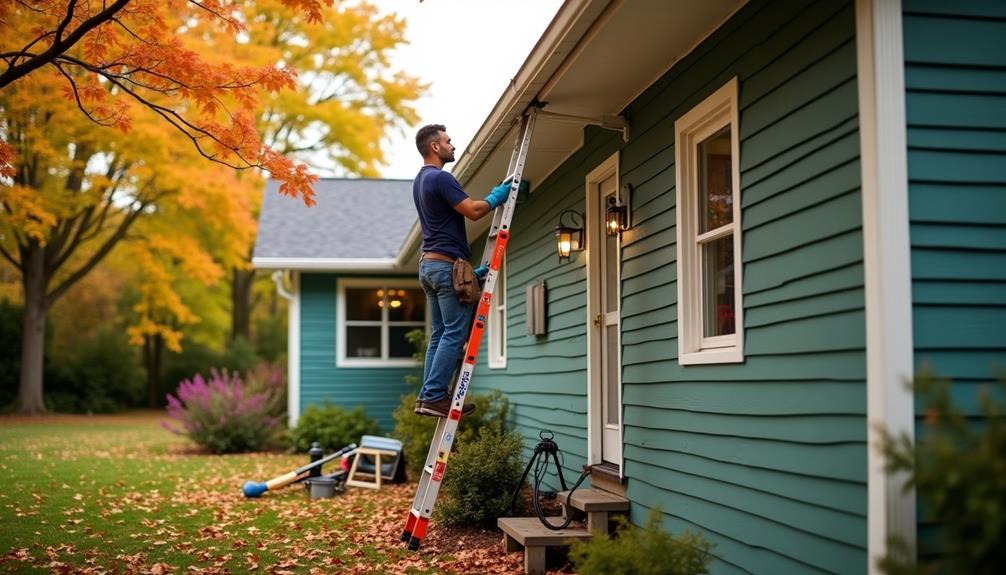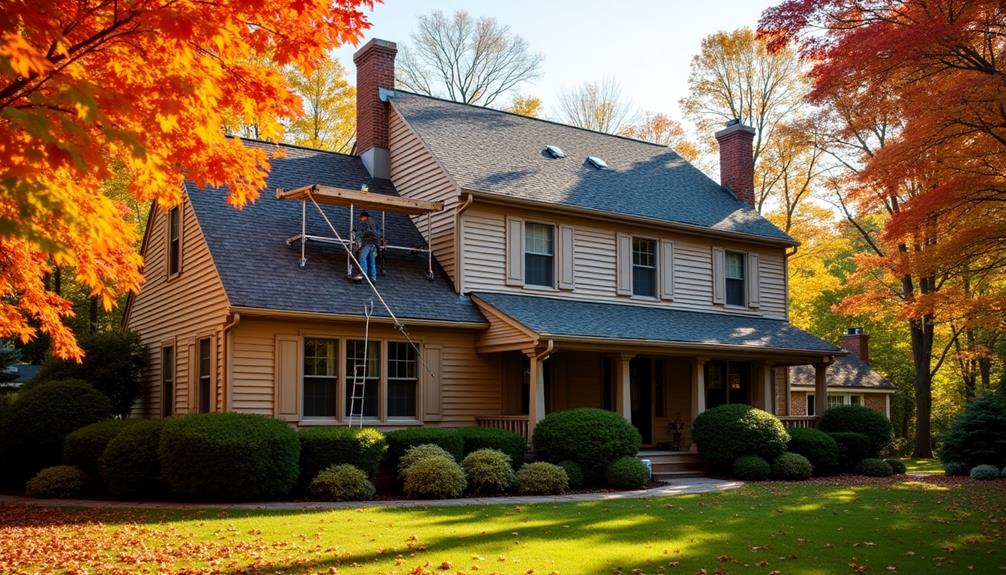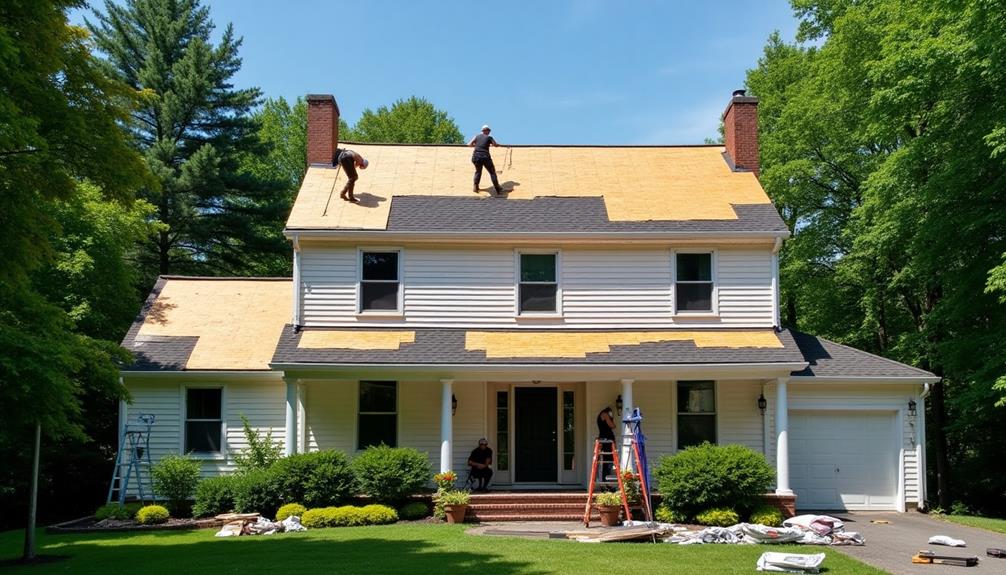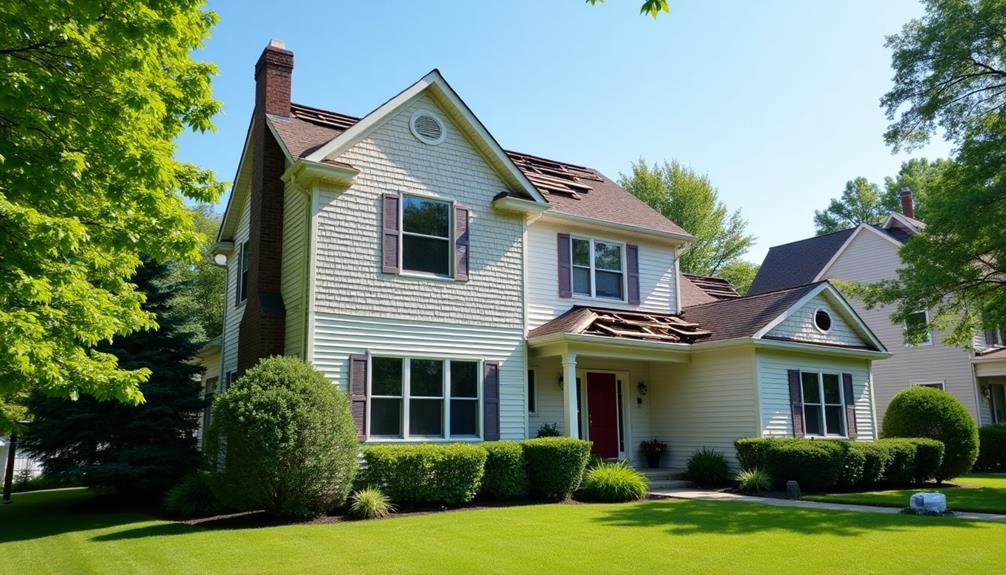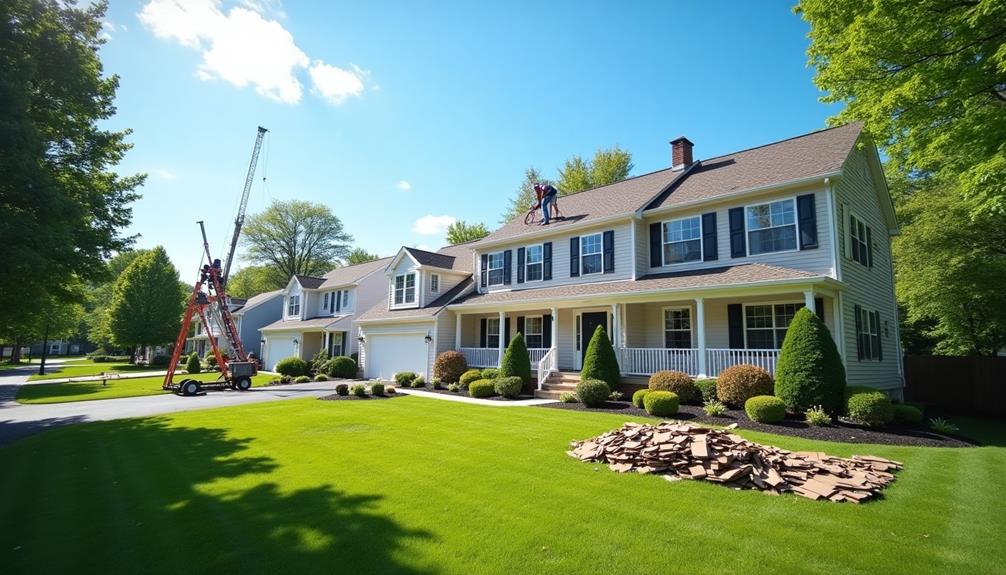If you're considering replacing or upgrading your home's gutters, you'll want to start by assessing your current system for any damage or inefficiencies. Choosing the right material is crucial, whether it's aluminum for durability or copper for aesthetics. You'll also need accurate measurements to ensure a proper fit. With the right tools and a step-by-step approach, the installation can be straightforward. But there are key upgrades that can enhance both functionality and appearance, and knowing these can make a significant difference in your home's maintenance and look.
Assessing Your Current Gutters
Before you dive into replacing or upgrading your gutters, it's crucial to assess their current condition. Start by checking for any visible damage, such as cracks, rust, or separation at the seams. These installation signs often indicate that your gutters mightn't last much longer.
Keep an eye out for leaks, as even small ones can lead to significant problems over time.
Next, consider the gutter lifespan. Most gutters can last anywhere from 20 to 50 years, depending on the material and maintenance. If your gutters are nearing the end of their lifespan, it's time to think about replacement.
Inspect the downspouts too; they should be clear of blockages and securely attached. If you notice sagging or misalignment, these are also telltale signs that your gutters need attention.
Additionally, check for water damage around your foundation or landscaping. If you see erosion or pooling water, it could mean your gutters aren't functioning properly.
Choosing the Right Gutter Material
When it comes to choosing the right gutter material, you have several options to consider. Each material varies in durability, cost, and maintenance needs, so it's crucial to weigh these factors based on your specific situation.
Let's explore the most common gutter materials and how they compare in terms of longevity and performance.
Common Gutter Materials
Choosing the right gutter material is crucial for ensuring your home's drainage system functions effectively. Different materials come with various benefits and drawbacks, so it's essential to consider your specific needs.
Aluminum is a popular choice due to its lightweight nature and resistance to rust. It's available in various gutter styles, including K-style and half-round, making it versatile for any home design.
Vinyl is another option that's easy to install and doesn't require painting. However, it can become brittle over time in extreme weather conditions.
If you're looking for a more durable solution, steel gutters might be your best bet. They're strong and can handle heavy rain, but they may require more maintenance to prevent rust.
Copper gutters offer a beautiful aesthetic and unmatched durability, but they come at a premium price point.
When considering installation tips, always remember that proper alignment and securing methods are vital for any gutter material. Each type has unique requirements, so research those specifics to ensure a smooth installation process.
Ultimately, the right choice will depend on your budget, style preferences, and maintenance willingness.
Material Durability Comparison
Understanding the durability of different gutter materials can significantly impact your decision. When you're comparing options, consider how long each material lasts. For instance, aluminum gutters typically have a lifespan of 20-30 years, while copper can last over 50 years.
This gutter lifespan comparison is crucial when you think about long-term investments for your home.
Next, evaluate the weather resistance of each material. Vinyl gutters are lightweight and resistant to rust, but they can become brittle in extreme cold. Steel gutters, on the other hand, offer strength and durability but may rust over time unless coated properly.
When you perform a weather resistance evaluation, think about the specific climate conditions in your area.
If you live in a region with heavy rainfall or snow, materials like steel or copper may be more suitable due to their strength. Conversely, if your area experiences mild weather, vinyl could be a cost-effective choice.
Ultimately, by weighing the durability and weather resistance of each material, you'll ensure your gutters perform effectively and protect your home for many years to come.
Measuring for New Gutters
Before you start measuring for new gutters, gather the right tools to ensure accuracy.
You'll need to calculate gutter lengths precisely and determine the best placement for downspouts.
Getting these measurements right is crucial for a successful installation.
Tools Needed for Measuring
When it comes to measuring for new gutters, having the right tools on hand makes the process much smoother. To ensure you get accurate measurements, you'll need a few proper measuring tools.
Start with a reliable tape measure, preferably one that extends at least 25 feet. This allows you to measure long runs of your roofline effectively.
Next, you'll want a level, which helps you check that your measurements are even and that your gutters will slope correctly for drainage. A chalk line can also be beneficial for marking straight lines along your roof's edge, giving you a visual guide as you measure.
Additionally, consider using a ladder that's sturdy and tall enough to reach your roofline safely, as well as a helper to hold the ladder or record measurements.
Lastly, having a notepad or a digital device handy can help you keep track of your measurements accurately.
Calculating Gutter Lengths
Calculating the lengths of your new gutters is crucial for ensuring proper fit and function. Start by measuring the entire perimeter of your roofline where the gutters will be installed. Use a tape measure to get accurate lengths, and note any corners or sections that may require special attention.
Remember to account for the gutter slope. A slight slope, typically around a quarter inch for every ten feet, helps water flow towards the downspouts. When measuring, consider this slope to ensure adequate drainage and prevent pooling.
If your roof has multiple sections or changes in elevation, break down the measurements into smaller segments. This method helps you avoid mistakes and makes it easier to calculate your gutter lengths accurately.
For installation tips, consider using a chalk line to mark where your gutters will sit, ensuring a straight line along the slope.
Double-check your measurements before purchasing materials, as it's better to have a bit extra than to come up short. By taking the time to measure correctly and understand gutter slope, you'll set yourself up for a successful gutter installation.
Determining Downspout Placement
Properly determining downspout placement is essential for effective water drainage. You need to consider the roof's slope, the gutter length, and where the water will flow when it rains.
Start by identifying the low points along your gutter run. These areas are where water tends to pool, making them ideal spots for downspouts.
Next, think about your home's downspout design. Ideally, you want to place downspouts at least every 30 feet along the gutter. This ensures that the water drains efficiently, minimizing the chances of overflow. Make sure to direct the downspouts away from your foundation to prevent potential water damage.
After selecting the locations, measure the distance from the gutter to the ground. This measurement helps you choose the right downspout size and ensures you can connect it properly to the drainage system.
Additionally, consider using downspout extensions or splash blocks to guide water further away from your home.
Tools and Materials Needed
To tackle the task of replacing and upgrading gutters effectively, you'll need a few essential tools and materials at your disposal.
Start with a sturdy ladder to reach high areas safely. A drill and a set of drill bits are crucial for securing the new gutters in place. Invest in a level to ensure your gutters are aligned properly, preventing water pooling.
You'll also need various materials depending on the gutter types you choose—whether aluminum, vinyl, or copper. Make sure to have the right lengths of gutters, downspouts, and elbow fittings.
Don't forget to grab gutter hangers and brackets for support, along with sealant and screws to keep everything tight and waterproof.
Additionally, having a measuring tape, a miter saw, and safety gear like gloves and goggles will enhance your efficiency and safety.
It's wise to familiarize yourself with installation tips specific to the gutter types you're using, as this will guide you through the process.
With these tools and materials ready, you'll be well-equipped to take on the task ahead.
Step-by-Step Installation Guide
Installing new gutters might seem daunting, but breaking it down into manageable steps makes the process straightforward. Start by measuring the length of the areas where your gutters will go. Cut your gutter sections to size, ensuring they fit snugly together. Use a level to mark where the hangers will go, typically every two feet along the length of the gutter.
Next, install the hangers according to your markings. Make sure they're securely fastened to the fascia board. Then, attach the gutter sections to the hangers, ensuring that they slope slightly toward the downspouts for proper drainage.
Once your gutters are up, install the downspouts, connecting them to the gutter system. Ensure that the downspouts direct water away from your home's foundation.
Finally, check for any leaks and seal them with silicone caulk.
For long-term success, remember these gutter installation tips: regularly check your gutters for debris and clean them out at least twice a year. This gutter maintenance advice will help you avoid clogs and ensure your system works effectively for years to come.
Upgrading Gutter Features
After getting your new gutters installed, you might consider enhancing their functionality and appearance with upgraded features.
One popular addition is gutter guards, which prevent debris from clogging your system, ensuring better water flow and energy efficiency. You can also explore decorative styles, like rain chains, that add a unique aesthetic appeal while directing water away from your home.
Seamless options are another excellent upgrade, as they minimize leaks and provide a sleek look.
When selecting your gutters, think about color choices that complement your home's exterior, enhancing its overall visual impact. Don't forget about ice prevention features; heated gutters can help in colder climates by reducing ice buildup.
While implementing these upgrades can improve functionality and aesthetics, keep cost considerations in mind. Balancing your budget with desired features is crucial.
You might find some upgrades are more affordable than others, so check installation tips to help you plan effectively.
Maintaining Your New Gutters
Maintaining your new gutters is crucial for ensuring they function properly and last for years to come. Start by scheduling regular gutter cleaning, ideally twice a year—once in the spring and once in the fall. This prevents debris buildup, which can lead to clogs and water damage. A simple inspection can reveal if you need to clean them more frequently, especially if you have overhanging trees.
In addition to cleaning, perform seasonal inspections to check for signs of wear and tear. Look for rust, cracks, or loose connections that might compromise your gutters' integrity. Pay special attention to the downspouts; they should be clear and directing water away from your foundation.
Don't forget to monitor how well your gutters handle heavy rainfall. If you notice overflow or leaks, it's a sign they may need immediate attention.
Lastly, consider investing in gutter guards to minimize debris accumulation. With these proactive measures, you can maintain your new gutters effectively, avoiding costly repairs down the line.
Regular upkeep not only enhances their lifespan but also keeps your home safe from water damage.

